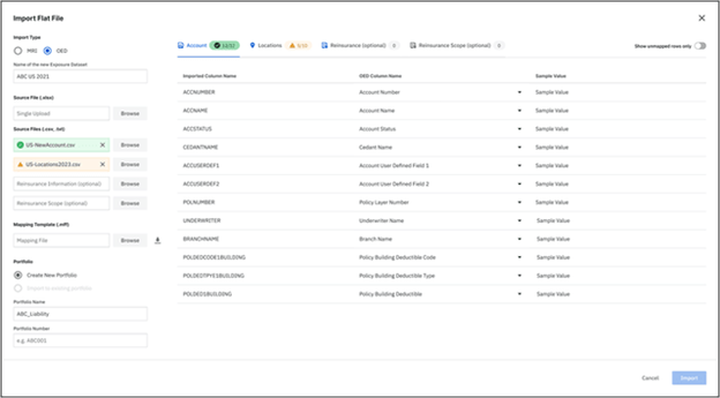For over 25 years, (re)insurers have invested in enterprise risk management to differentiate their businesses through superior underwriting, portfolio management, and capital management.
Firms that have excelled in this paradigm have been able to establish effective risk management guidelines, use models and data to effectively price risk, and balance the need to grow together with exposing their businesses to well-managed losses.
Yet, as new technologies and standards emerge, firms are just beginning to see how their IT investment is impacting the flow of data. Divergent data schemas are making it more difficult to build a unified view of risk across disciplines and stakeholders.
Far too often, the management of the data schema becomes an anchor for an organization, making it difficult to respond to market challenges.
As firms evaluate their risk analytics strategies, openness should be a key consideration – as adopting platforms built with open standards, technologies, and APIs can become a differentiator.
Harnessing the power of advanced analytic capabilities, like artificial intelligence and Large Language Models, for example, can also foster greater innovation and collaboration to help the industry build a more resilient marketplace.
Building a More Innovative and Open Platform
I am thrilled to announce Moody’s RMS Intelligent Risk Platform™ has taken another step toward becoming a more open and collaborative risk platform.
Risk managers can now import and transform the Oasis Open Exposure Data (OED) schema, in addition to Verisk/AIR’s Catastrophe Exposure Database Exchange (CEDE) schema into Exposure Data Modules (EDM).
Clients no longer need to invest in developing, testing, and maintaining these complex schema mapping tools and deal with multiple versions of EDM, CEDE, and OED.
The Intelligent Risk Platform (IRP) now addresses the complexity of exposure data schema mappings directly in the platform, allowing engineering and modeling teams to spend more time analyzing risk rather than rekeying and manipulating data.
Once your exposure is on the platform, you’ll benefit from:
- Our Powerful Ecosystem of Collaborative Applications: Including UnderwriteIQ™, ExposureIQ™, and Risk Modeler™, to run advanced underwriting, portfolio management, and catastrophe modeling analysis.
- Less Model Vendor Lock-in: If you prefer a Moody’s RMS view of risk over another vendor, the schema of your exposure should not deter you from making a change.
- Access to Award-Winning Catastrophe Risk Insights: Access over 400 catastrophe models across 93 countries, built using the latest science, data, and approaches to help the P&C industry better understand the increasingly complex and interconnected world of natural and man-made risk.
- Ability to Run Oasis Loss Models on Your CEDE Data: With Open Model Engine capability, the IRP enables you to import CEDE data and execute Oasis Loss Models, giving you greater modeling choices outside of our model portfolio.
- Fast, Powerful, and Highly Scalable Environment: Ensures 24/7 availability and superior performance. Standardized APIs increase workflow automation and simplify embedding insights into new and existing workflows, freeing up time for high-value tasks.
Transforming Oasis (Open Exposure Data) into New Actionable Insights
The OED standard has been around for more than five years and is utilized by 300 models on the Oasis Loss Modeling Framework (LMF).
As the OED standard gains increasing acceptance in the industry, companies that adopt a single exposure schema might see an impact on their business.
To illustrate, consider a scenario where a broker submits a portfolio for reinsurance placement using OED. If the reinsurer's primary risk perspective is based on a model that operates on the EDM, the reinsurer is confronted with a challenging choice:
- Pass on the business, forgoing the opportunity to bid on the risk
- Manually convert the OED data into an EDM, a process that could be resource-intensive and potentially introduce human error, or
- Depend on the broker's analysis, effectively relinquishing their meticulously developed risk perspective.
Each of these alternatives can potentially erode the reinsurer's profits, either through revenue loss, increased risk analysis costs, or the need to reserve additional capital to account for the uncertainty arising from differing risk viewpoints.
In contrast, the Intelligent Risk Platform proposes a more streamlined approach.
Either a (re)insurer or a broker can simply import the OED data into the platform, execute model(s), and perform analytics.
Mapping exposure stored in an OED schema into the EDM faces similar challenges as with the CEDE to EDM mapping. Everything from peril mapping to secondary modifier mapping needs to be developed. (You can learn more about this process in this blog).
While the CEDE schema consists of a database file (MDF / BAK), the OED schema consists of four text files: Account, Location, Reinsurance Info, and Reinsurance Scope. Because of this, the workflow for importing OED files is different than importing the CEDE database.
The OED import workflow (see below) aligns with the existing import workflow for MRI files and that is where users will get an option to select OED to import those files into the platform.

Conclusion
Expanding access to more exposure schemas on the Intelligent Risk Platform highlights our commitment to building a more open and collaborative platform.
Our new capabilities to transform OED into EDM demonstrate progress in tackling the practical challenges of running Moody’s RMS models, a client’s home-grown models, and Oasis LMF models on a single unified platform.
As we continue to near the release of our open modeling engine and native modeling engines, we will continue to update the market on our progress.










